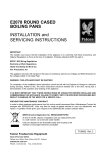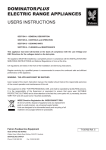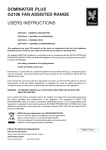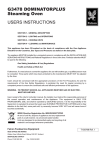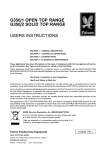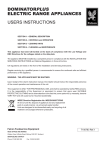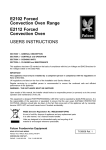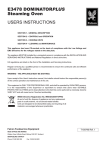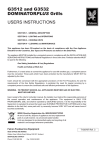Download User Manual - Cedtrade.co.uk
Transcript
E2078 ROUND CASED BOILING PANS USERS INSTRUCTIONS SECTION 1 - GENERAL DESCRIPTION SECTION 2 - CONTROLS and OPERATION SECTION 3 - CLEANING and MAINTENANCE This appliance has been CE-marked on the basis of compliance with the Low Voltage and EMC Directives for the voltages stated on the Data Plate. IMPORTANT This appliance must only be installed by a competent person in compliance with the regulations in force at the time. UK regulations are listed on the front of the Installation and Service Manual. Regular servicing by a qualified person is recommended to ensure the continued safe and efficient performance of the appliance. WARNING - THIS APPLIANCE MUST BE EARTHED! Upon receipt of this manual, the installer should instruct a responsible person (or persons) as to the correct operation and maintenance of the unit. This equipment is designed FOR PROFESSIONAL USE ONLY and be operated by QUALIFIED persons. It is the responsibility of the supervisor or equivalent to ensure that the user wears SUITABLE PROTECTIVE CLOTHING. Attention should also be drawn to the fact that some parts of the appliance will, by necessity, become VERY HOT and could cause burns if touched accidentally. WEEE Directive Registration No. WEE/DC0059TT/PRO At end of unit life, dispose of appliance and any replacement parts in a safe manner, via a licenced waste handler. Units are designed to be dismantled easily and recycling of all material is encouraged whenever practicable. Falcon Foodservice Equipment HEAD OFFICE AND WORKS Wallace View, Hillfoots Road, Stirling. FK9 5PY. Scotland. SERVICELINE CONTACT PHONE - 01438 363 000 FAX - 01438 369 900 T100562 Ref. 2 SECTION 1 - GENERAL DESCRIPTION Heating Up This manual covers operation of the following appliances. Fill pan as required, switch on at mains supply and turn regulator knob to desired setting. For rapid heating, knob must be turned FULL ON. For subsequent simmering, it can be turned to a lower setting as required. Amber neon indicates operation of regulator and will go on and off as elements are intermittently supplied with current. Red neon remains lit when the main switch is ON. E2078 Single Purpose (45 litre) E2078 Single Purpose (90 litre) E2078 Single Purpose (135 litre) Both models incorporate a one piece, stainless steel pan and hob with a protective finish on the inner casing. A lift-off cover is provided and may be stored in the rack at pan rear when not in use. A perforated stainless steel strainer plate and chrome plated cold water swivel filling arm are also fitted. An easy to clean drain tap is also provided. A kit which converts single purpose pans for dual purpose operation is available. Swivel Tap Operating Control Important Pan contents should not be drained immediately after switching off. Wait until boiling has ceased. When lifting the cover from a hot pan, hold centre handle and raise rear edge first. This will allow steam to be directed away from the operator. Lift cover to a vertical position, this will allow condensation to drip back into pan. Store cover in side-mounted rack and ladle out contents from inner pan. Single Purpose Pans Filler Funnel Drain Tap Drain Tap Safety Catch SECTION 2 - CONTROLS and OPERATION All three models are heated by means of elements located below pan base, controlled by means of an energy regulator. Warning UNDER NO CIRCUMSTANCES MUST THE ELEMENTS BE TURNED ON WHEN PAN IS EMPTY, NOR SHOULD IT BE LEFT TO BOIL DRY. FAILURE TO OBSERVE THIS WILL INVALIDATE THE WARRANTY Filling Level Before filling pan, ensure that drain cock is closed by turning operating handle fully left. The nominal capacity is indicated by level mark on pan rear wall located 75mm below brim. THIS MUST NOT BE EXCEEDED IF BOILING OVER IS TO BE PREVENTED. Dual Purpose Model The outer jacket of a dual purpose pan requires a level of 50mm. This is indicated by the mark on filler pot when pan is clamped in position. The pan itself should be filled to no further than level with outer pan brim. These are best suited for heating water and cooking vegetables, etc. Thick soup and milk based products are best prepared in a dual purpose model. This will help the operator to avoid sticking or burning due to direct heat. As a general guide, the pan will take approximately one hour to reach boiling from cold when filled to capacity with water. Where vegetable baskets or containers are used, these should be placed on the strainer plate. Dual Purpose Pan Kit A separate pan is supplied that fits within the single purpose vessel. This inner pan is held in position by clamps and a filler pot is provided to enable jacket space to be filled with water. These are primarily intended for heating foods such as milk dishes where an indirect heat is desired to prevent burning. Certain precautions should be observed to obtain best results. When used for indirect heating, the inner pan is positioedn and secured by means of spring-loaded swivel clamps. Outer pan is then filled with water using the funnel and swivel tap. The level is correct when there is 50mm of water (up to the level mark on filler pot) WHEN INNER PAN IS LOCKED IN POSITION BY CLAMPS. Dual purpose inner pans should be filled to no more than brim level to outer pan. When water in outer pan starts to boil, the switch should be immediately turned down to a rate that will maintain simmering. Otherwise, water will bubble out between inner pan flange and hob. SECTION 3 - COOKING HINTS USING THE PAN Do not turn on elements when pan is empty. Do not overfill the pan Single purpose pans are best suited for heating water to cook vegetables, boil gammon etc. Milk based foods, such as custard or mild puddings, are best cooked in a dual purpose pan (i.e. using inner pan) to avoid sticking and/or burning due to direct heat. The following advice should be adhered to for the safety of the end user and other catering staff within the kitchen area. When using a single purpose pan, the pan should be charged with food/water as required, NEVER over- filled and then burner should be lit. The element control should then be adjusted to appropriate setting for the product being cooked. When vegetable baskets or containers are used, these should be placed upon the strainer plate. When using inner pan, position it and clamp in position. Fill outer pan using filler pot to a visible depth of 50mm and replace pot cover. Charge inner pan with food as required and switch on. Allow pan to heat up, adjust control to maintain simmer in outer pan between full and low rate. Do not leave full on or water between pans will evaporate away. Top up water level in outer pan periodically to maintain correct level. As a general guide, pan will take approximately 1 hour to boil from cold when filled to capacity with water. When food has been cooked and is ready for service the unit should be turned off to cease cooking process. When lifting cover from a hot pan, grasp centre handle and raise rear edge first. This will direct steam away from operator. Lift cover to a vertical position to allow condensation to drip back into pan and store in side mounted rack. The food should then be removed from pan into a smaller serving receptacle, such as a bain marie container or a deep gastronorm container. This transfer manoeuvre should be carried using a ladle or baler. The dish that food is transferred into must be placed upon a steady flat worktop. This will eliminate risk of burning and spillage. Place lid upon pan to retain heat within food product. When serving container is empty and requires topping up, remove lid and repeat above procedure. SECTION 4 - CLEANING and MAINTENANCE THE APPLIANCE MUST NOT BE CLEANED WITH A JET OF WATER OR STEAM CLEANED. Regular cleaning is essential with this type of appliance. The unit has been designed with emphasis on ease of cleaning, dirt retaining crevices being eliminated and smooth, curved surfaces being utilized wherever possible. Before cleaning, SWITCH OFF AT MAIN SWITCH. Regular cleaning is best undertaken when pan is still warm, after completion of work. Always check that drain tap and dual purpose filler funnel pipe are free from obstruction. After draining, wash pan interior with warm water and detergent. Rise it thoroughly afterward. Avoid use of harsh scouring powders, nylon scrubbers etc. which may scratch the stainless steel surface. Do not wash down electrical control box, if cleaning is necessary use a dry or slightly damp cloth. Important Notes Pan bowl must be drained completely after use and washed out and wiped down, preferably when pan is still warm. Cleaning materials of an acidic nature must not be used to clean the pan. Drain Tap This is a special design for ease of cleaning. Instructions on how to dismantle this component are printed on a label on top of the tap. Lift up safety catch and the handle fully. Turn tap to ON position and lift up plug. When re-assembling, lift up safety catch and handle. Insert plug and turn tap to OFF position. Drop catch and handle. The plug should always be lubricated and never be operated dry. A good quality frying oil may be used as a lubricant. NEVER LIFT SAFETY CATCH WHEN PAN CONTAINS LIQUID.




